
1Paul M Dewick Medicalc Natural / booktext@id88013691placeboie
.pdf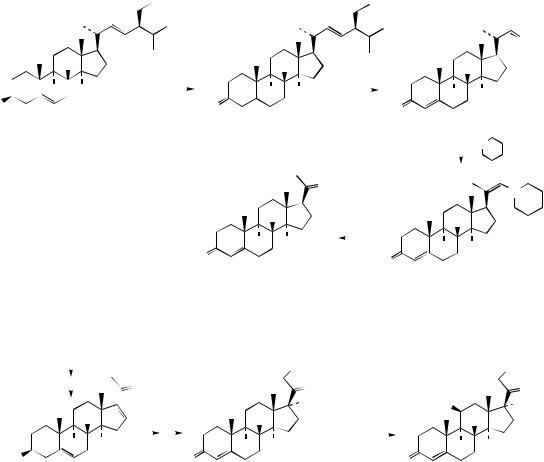
STEROIDS |
267 |
H
A  H
H  H
H
HO
stigmasterol
Oppenauer oxidation of 3-hydroxyl to ketone, with tautomerism to give
ozonolysis to cleave
conjugated system
side-chain double bond
O
Al(OiPr)3 |
H |
|
|
|
|
|
|
H |
|
Me2CO |
|
|
|
O3 |
|
|
|||
|
H |
|
H |
|
|
|
H H |
||
|
|
||||||||
|
|
|
|
||||||
|
O |
|
|
|
|
|
O |
|
|
|
|
|
enamine formation: Schiff base |
|
HN |
||||
|
|
|
|
||||||
|
|
|
(iminium) formed first, |
|
|||||
|
|
|
followed by base-catalysed |
|
|
||||
|
|
|
|
|
|||||
|
|
|
iminium−enamine tautomerism |
|
|
||||
|
|
|
O |
|
N |
||||
|
|
|
|
|
|
|
|
|
|
|
H |
|
|
|
|
|
|
H |
|
|
|
|
|
CrO3 |
|||||
|
|
|
|
|
|
||||
|
H |
H |
|
|
|
|
H |
|
H |
|
|
|
|
|
|
||||
|
|
|
|
|
|
|
|
||
O |
|
O |
|
progesterone |
|
|
selective oxidation of |
|
|
|
|
|
|
side-chain double bond |
Figure 5.120
diosgenin
Marker |
|
|
|
|
|
|
|
OH |
|
|
|
|
OH |
degradation |
|
|
|
|
|
|
|
|
|
|
|||
|
|
|
|
|
|
|
|
|
|
|
|
||
(Figure 5.119) |
|
O |
|
|
|
|
O |
|
|
|
|
O |
|
|
|
|
|
|
|
|
|
|
|
||||
|
|
|
|
|
|
|
|
OH |
|
|
|
HO |
OH |
|
H |
|
|
chemically |
11 |
|
|
|
|
|
|||
|
|
|
H |
Curvularia lunata |
|
H |
|||||||
|
|
|
|
|
|
|
|
||||||
H H |
|
|
|
|
|
|
H H |
|
|
|
H |
H |
|
|
|
|
|
|
|
|
|
|
|||||
|
|
|
|
|
|
60% |
|
||||||
|
|
|
|
|
|
|
|
|
|
|
|
||
AcO |
|
|
|
|
|
O |
|
|
|
|
O |
|
|
dehydropregnenolone |
|
|
|
|
|
|
cortexolone |
|
|
|
hydrocortisone |
||
acetate |
|
|
|
|
|
|
|
|
|
|
(cortisol) |
||
Figure 5.121
Although a natural corticosteroid, cortexolone may be obtained in large amounts by chemical transformation from 16-dehydropregnenolone acetate, an intermediate in the Marker degradation of diosgenin (Figure 5.119).
Some steroid drugs are produced by total synthesis, but, in general, the ability of microorganisms to biotransform steroid substrates has proved invaluable in exploiting inexpensive natural steroids as sources of drug materials. It is now possible via microbial fermentation to hydroxylate the steroid nucleus at virtually any position and with defined stereochemistry. These
processes are in general more expensive than chemical transformations, and are only used commercially when some significant advantage is achieved, e.g. replacement of several chemical steps. The therapeutic properties of cortisone and hydrocortisone can be further improved by the microbial introduction of a 1,2-double bond, giving prednisone and prednisolone respectively (Figure 5.122). These agents surpass the parent hormones in antirheumatic and antiallergic activity with fewer side effects. As with cortisone, prednisone is converted in the body into the active agent, in this case prednisolone.
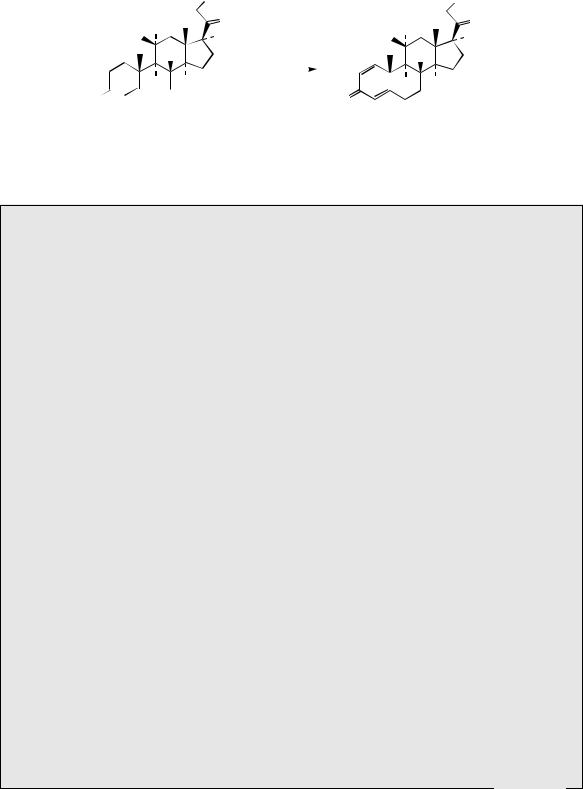
268 |
THE MEVALONATE AND DEOXYXYLULOSE PHOSPHATE PATHWAYS |
|
|
|
OH |
||
|
R2 |
|
O |
||
R1 |
|
OH |
|||
|
|
||||
1 |
|
H |
Arthrobacter simplex |
||
2 |
H |
H |
|
|
|
|
60–90 % |
||||
|
|
||||
O 
 R1R2 = O, cortisone
R1R2 = O, cortisone
R1 = OH, R2 = H, hydrocortisone (cortisol)
|
|
OH |
|
|
R2 |
O |
|
R1 |
OH |
||
|
|||
|
|
H |
|
|
H |
H |
O
R1R2 = O, prednisone
R1 = OH, R2 = H, prednisolone
Figure 5.122
Corticosteroid Drugs
Glucocorticoids are primarily used for their antirheumatic and anti-inflammatory activities. They give valuable relief to sufferers of rheumatoid arthritis and osteoarthritis, and find considerable use for the treatment of inflammatory conditions by suppressing the characteristic development of swelling, redness, heat, and tenderness. They exert their action by interfering with prostaglandin biosynthesis, via production of a peptide that inhibits the phospholipase enzyme responsible for release of arachidonic acid from phospholipids (see page 55). However, these agents merely suppress symptoms and they do not provide a cure for the disease. Long term usage may result in serious side-effects, including adrenal suppression, osteoporosis, ulcers, fluid retention, and increased susceptibility to infections. Because of these problems, steroid drugs are rarely the first choice for inflammatory treatment, and other therapies are usually tried first. Nevertheless corticosteroids are widely used for inflammatory conditions affecting the ears, eyes, and skin, and in the treatment of burns. Some have valuable antiallergic properties helping in reducing the effects of hay fever and asthma. In some disease states, e.g. Addison’s disease, the adrenal cortex is no longer able to produce these hormones, and replacement therapy becomes necessary. The most common genetic deficiency is lack of the 21-hydroxylase enzyme in the biosynthetic pathway, necessary for both hydrocortisone and aldosterone biosynthesis (Figure 5.114). This can then lead to increased synthesis of androgens (see Figure 5.133).
Mineralocorticoids are primarily of value in maintaining electrolyte balance where there is adrenal insufficiency.
Natural corticosteroid drugs cortisone (as cortisone acetate) and hydrocortisone
(cortisol) (Figure 5.112) are valuable in replacement therapies, and hydrocortisone is one of the most widely used agents for topical application in the treatment of inflammatory skin conditions. The early use of natural corticosteroids for anti-inflammatory activity tended to show up some serious side-effects on water, mineral, carbohydrate, protein, and fat metabolism. In particular, the mineralocorticoid activity is usually considered an undesirable effect. In an effort to optimize anti-inflammatory activity, many thousands of chemical modifications to the basic structure were tried. Introduction of a ∆1 double bond modifies the shape of ring A and was found to increase glucocorticoid over mineralocorticoid activity, e.g. prednisone and prednisolone (Figure 5.122). A 9α-fluoro substituent increased all activities, whereas 16αor 16β-methyl groups reduced the mineralocorticoid activity without affecting
(Continues)
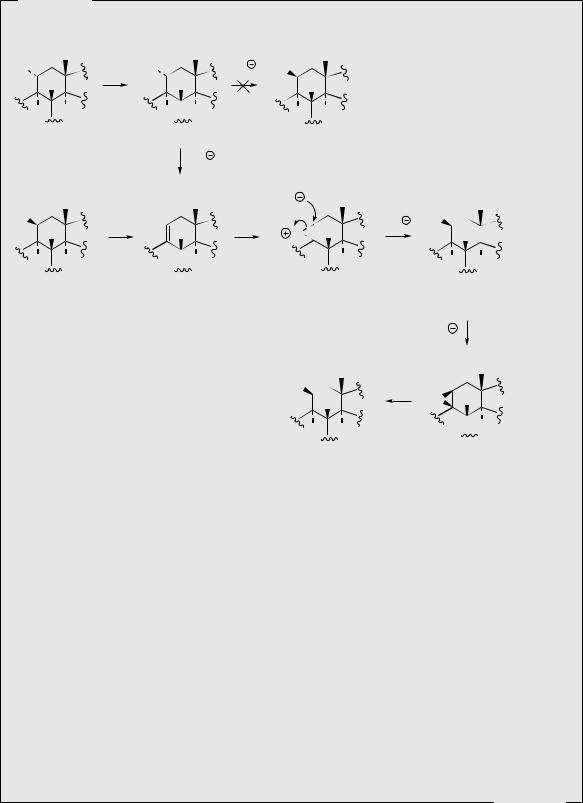
STEROIDS |
269 |
(Continued )
|
esterification with tosyl chloride |
SN2 displacement |
|
|
|
|||
|
to generate good leaving group |
does not occur |
|
|
|
|||
|
|
|
|
|
|
|
||
HO 11 |
TsCl |
TsO |
|
AcO AcO |
|
|
|
|
|
|
|
|
|
|
|
|
|
9 |
H |
|
H |
|
H |
|
|
|
H |
H |
|
H H |
|
H |
H |
|
|
|
base-catalysed |
AcO |
|
|
|
|
|
|
|
E1 elimination |
|
|
|
|
|
||
|
|
|
|
|
|
|
||
|
|
|
|
|
HO |
|
|
|
HO |
SOCl2 |
/ Py |
|
Br2 |
|
|
HO |
|
|
|
Br |
H |
HO |
|
|||
|
H |
|
H |
|
|
H |
||
H |
H |
|
H |
|
|
|
H |
Br H |
|
E2 elimination |
|
bromination from |
|
|
|
||
|
|
|
|
less-hindered α face |
|
|
|
|
|
|
|
|
|
|
|
|
base-catalysed |
|
|
|
|
|
|
|
AcO |
intramolecular SN2 |
|
|
|
|
|
|
|
|
gives epoxide |
|
|
|
|
|
HO |
|
HF |
|
|
|
|
|
|
|
|
|
|
|
|
|
|
|
|
H |
O |
H |
|
|
|
|
|
|
|
|
|
|
|
|
|
|
F |
|
H |
H |
|
|
|
|
|
|
|
||
acid-catalysed opening of epoxide (favouring trans-fused ring system)
Figure 5.123
the glucocorticoid activity. The discovery that 9α-fluoro analogues had increased activity arose indirectly from attempts to epimerize 11α-hydroxy compounds into the active 11β-hydroxy derivatives (Figure 5.123). Thus, when an 11α-tosylate ester was treated with acetate, a base-catalysed elimination was observed rather than the hoped-for substitution, which is hindered by the methyl groups (Figure 5.123). This syn elimination suggests an E1 mechanism is involved. The same ∆9(11)-ene can also be obtained by dehydration of the 11β-alcohol by using thionyl chloride. Addition of HOBr to the 9(11)-double bond proceeds via electrophilic attack from the less-hindered α-face, giving the cyclic bromonium ion, and then ring opening by β-attack of hydroxide at C-11. Attack at C-9 is sterically hindered by the methyl at C-10. 9αBromocortisol 21-acetate produced in this way was less active as an anti-inflammatory than cortisol 21-acetate by a factor of three, and 9α-iodocortisol acetate was also less active by a factor of ten. Fluorine must be introduced indirectly by the β-epoxide formed by base treatment of the 9α-bromo-10β-hydroxy analogue (Figure 5.123). The resultant 9α-fluorocortisol 21acetate (fluorohydrocortisone acetate; fludrocortisone acetate) (Figure 5.124) was found to be about 11 times more active than cortisol acetate. However, its mineralocorticoid activity was
(Continues)
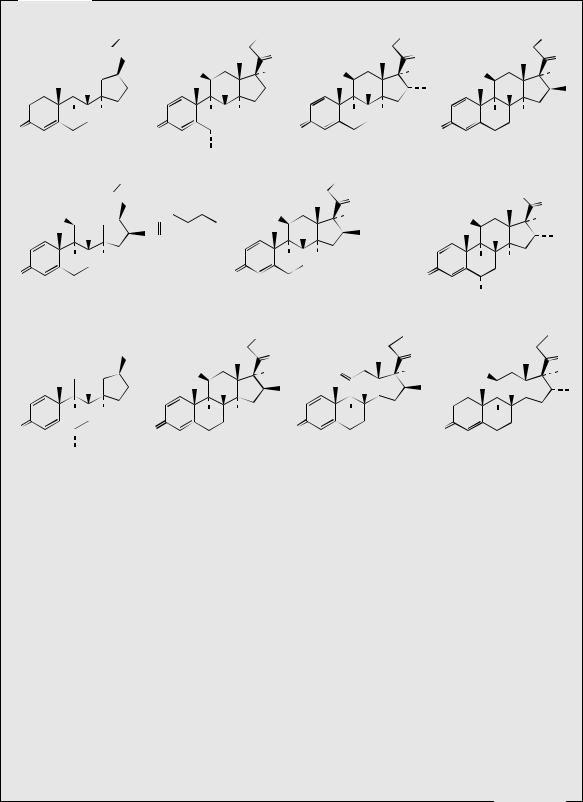
270 |
THE MEVALONATE AND DEOXYXYLULOSE PHOSPHATE PATHWAYS |
(Continued )
OAc
 O
O
HO


 OH
OH
H
F  H
H
O O
fludrocortisone acetate (9α-fluorocortisol acetate)
OH
 O
O
HO 



 O
O
H
O
F  H
H
O
betamethasone 17-valerate
 O
O
HO


 OH
OH
H
F  H
H
O  O
O
|
OH |
|
|
OH |
|
OH |
|
O |
|
|
O |
|
O |
HO |
OH |
HO |
|
OH |
HO |
OH |
|
H |
H |
|
|
|
H |
H |
H |
F |
H |
|
F |
H |
|
O |
|
|
O |
|
|
|
|
dexamethasone |
|
betamethasone |
||
methylprednisolone |
|
|
|
|
|
|
|
|
OCOEt |
|
|
|
|
|
|
O |
|
|
FH2CS |
|
|
|
|
|
|
O |
|
|
|
|
|
|
|
|
|
HO |
OCOEt |
|
HO |
OCOEt |
|
|
H |
|
|
|
H |
|
|
|
|
|
|
|
|
|
X |
H |
|
|
F |
H |
|
|
|
|
|
||
|
O |
|
|
O |
|
|
|
|
|
|
|
|
|
|
X = F, betamethasone 17,21-dipropionate |
|
F |
|
||
|
X = Cl, beclometasone (beclomethasone) |
|
fluticasone propionate |
|||
|
17,21-dipropionate |
|
|
|
|
|
|
Cl |
|
|
Cl |
|
|
|
O |
|
|
O |
|
O |
HO |
OCOEt |
O |
|
OCOPr |
HO |
|
|
H |
H |
|
|
|
H |
F |
H |
F |
H |
|
H |
H |
|
O |
|
|
O |
|
|
fluorometholone |
clobetasol 17-propionate |
clobetasone 17-butyrate |
rimexolone |
Figure 5.124
also increased some 300-fold, so its anti-inflammatory activity has no clinical relevance, and it is only employed for its mineralocorticoid activity. The introduction of a 9α-fluoro substituent into prednisolone causes powerful Na+ retention. These effects can be reduced (though usually not eliminated entirely) by introducing a substituent at C-16, either a 16α-hydroxy or a 16α/16β-methyl. The 16α-hydroxyl can be introduced microbiologically, e.g. as in the conversion of 9α-fluoroprednisolone into triamcinolone (Figure 5.125). The ketal formed from triamcinolone and acetone, triamcinolone acetonide (Figure 5.125) provides a satisfactory means of administering this anti-inflammatory by topical application in the treatment of skin disorders such as psoriasis. Methylprednisolone (Figure 5.124) is a 6α-methyl derivative of prednisolone showing a modest increase in activity over the parent compound. A 6-methyl group can be supplied by reaction of the Grignard reagent MeMgBr with a suitable 5,6-epoxide derivative. Dexamethasone and betamethasone (Figure 5.124) exemplify respectively 16αand 16β-methyl derivatives in drugs with little, if any, mineralocorticoid activity. The 16-methyl group is easily introduced by a similar Grignard reaction with an appropriate α,β-unsaturated ∆16-20-ketone. Betamethasone, for topical application, is typically formulated as a C-17 ester with valeric acid (betamethasone 17-valerate), or as
(Continues)
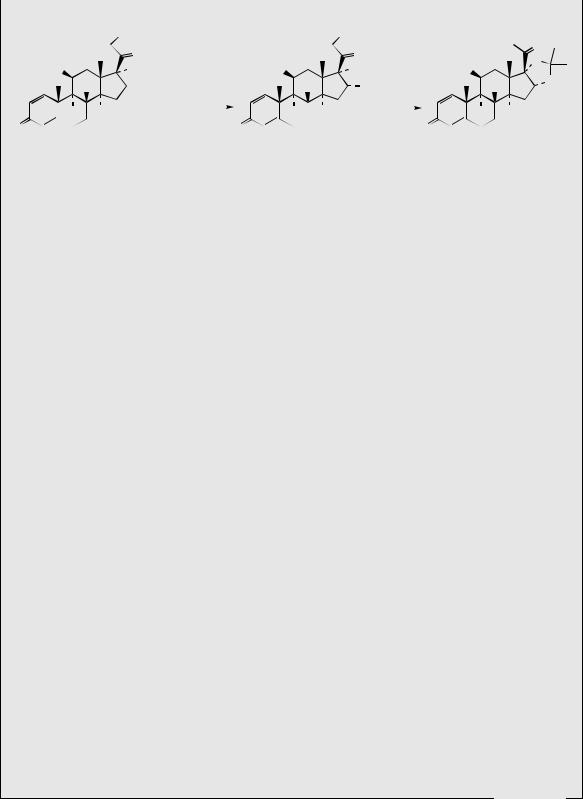
|
|
|
|
STEROIDS |
|
|
|
271 |
|
|
(Continued ) |
|
|
|
|
|
|
|
|
|
OH |
|
|
|
OH |
|
|
OH |
|
|
|
|
|
|
|
|
|||
|
|
O |
|
|
|
O |
|
|
O |
|
|
|
|
|
|
|
O |
||
|
HO |
OH |
|
HO |
|
OH |
|
HO |
|
|
|
|
|
|
|||||
|
H |
16 |
Streptomyces |
H |
OH |
|
H |
O |
|
|
|
|
roseochromogenus |
|
|
Me2CO |
|
||
|
F |
H |
|
F |
H |
|
|
F |
H |
|
|
|
|
||||||
O |
|
|
O |
|
|
|
O |
|
|
|
9α-fluoroprednisolone |
|
triamcinolone |
|
|
triamcinolone |
|||
acetonide
Figure 5.125
the 17,21-diester with propionic acid (betamethasone 17,21-dipropionate) (Figure 5.124). The 9α-chloro compound beclometasone 17,21-dipropionate (beclomethasone 17,21dipropionate) is also an important topical agent for eczema and psoriasis, and as an inhalant for the control of asthma. Fluticasone propionate (Figure 5.124) is also used in asthma treatment, and is representative of compounds where the 17-side-chain has been modified to a carbothiate (sulphur ester).
Although the anti-inflammatory activity of hydrocortisone is lost if the 21-hydroxyl
group is not |
present, |
considerable |
activity is |
restored when a |
9α-fluoro substituent |
is introduced. |
Fluorometholone (Figure 5.124) |
is a corticosteroid that exploits this |
|||
relationship and is of |
value in eye |
conditions. |
Other agents are |
derived by replacing |
|
the 21-hydroxyl with a halogen, e.g. clobetasol 17-propionate and clobetasone 17-
butyrate (Figure 5.124), which |
are effective |
topical drugs for severe |
skin |
disorders. |
||||
In |
rixemolone, |
a recently introduced anti-inflammatory |
for |
ophthalmic use, neither |
||||
a |
21-hydroxy |
nor a 9α-fluoro |
substituent |
is present, |
but |
instead |
there |
are 17α- |
and 16α-methyl substituents. Rimexolone has significant advantages in eye conditions over drugs such as dexamethasone, in that it does not significantly raise intraocular pressure.
Many other corticosteroids are currently available for drug use. Structures of some of these are given in Figure 5.126, grouped according to the most characteristic structural features, namely 16-methyl, 16-hydroxy, and 21-chloro derivatives. The recently introduced deflazacort (Figure 5.127) is a drug with high glucocorticoid activity, but does not conveniently fit into any of these groups in that it contains an oxazole ring spanning C-16 and C-17.
Trilostane (Figure 5.127) is an adrenocortical suppressant, which inhibits synthesis of glucocorticoids and mineralocorticoids and has value in treating Cushing’s syndrome, characterized by a moon-shaped face and caused by excessive glucocorticoids. This drug is an inhibitor of the dehydrogenase–isomerase that transforms pregnenolone into progesterone (Figures 5.92 and 5.114).
Spironolactone (Figure 5.127) is an antagonist of the endogenous mineralocorticoid aldosterone and inhibits the sodium-retaining action of aldosterone whilst also decreasing the potassium-secreting effect. Classified as a potassium-sparing diuretic, it is employed in combination with other diuretic drugs to prevent excessive potassium loss. Progesterone (page 273) is also an aldosterone antagonist; the spironolactone structure differs from progesterone in its 7α-thioester substituent, and replacement of the 17β side-chain with a 17α-spirolactone.
(Continues)

272 |
THE MEVALONATE AND DEOXYXYLULOSE PHOSPHATE PATHWAYS |
(Continued ) |
|
|
|
|
|
|
|
|
|
|
|
|
|
OH |
|
|
OH |
|
|
OH |
|
|
|
OH |
|
|
|
O |
|
|
O |
|
|
O |
|
|
|
O |
HO |
OH |
HO |
|
|
|
HO |
|
|
HO |
|
OH |
|
|
H |
|
|
H |
|
|
H |
|
|
|
H |
|
H |
H |
|
F |
|
H |
|
F |
H |
|
F |
H |
|
O |
Cl |
|
O |
|
|
O |
|
|
O |
|
|
|
|
|
|
|
|
|
|
F |
|
|
F |
|
|
alclometasone |
|
desoximetasone |
|
diflucortolone |
flumetasone (flumethasone) |
|||||||
(used as 17,21-dipropionate) |
(desoxymethasone) |
|
(used as 21-valerate) |
[used as pivalate (trimethylacetate)] |
||||||||
|
OH |
|
|
|
OH |
|
|
OH |
|
|
|
OH |
|
O |
|
|
O |
|
|
O |
|
|
|
O |
|
|
|
|
O RS |
|
|
O |
|
|
|
O |
||
HO |
|
|
HO |
|
|
HO |
|
HO |
|
|||
|
|
|
O |
|
O |
|
|
O |
||||
|
H |
|
|
H |
|
H |
|
|
H |
|||
|
|
|
|
|
|
|
|
|
||||
H |
H |
|
H |
|
H |
|
H |
H |
|
H |
H |
|
O |
|
|
O |
|
|
O |
|
|
O |
|
|
|
F |
|
|
|
|
|
|
F |
|
|
F |
|
|
fluocortolone |
|
budesonide |
|
fludroxycortide |
|
flunisolide |
|
|||||
(used as 21-hexanoate) |
|
|
|
|
|
(flurandrenolone) |
|
|
|
|
||
|
OH |
|
|
|
OAc |
|
|
Cl |
|
|
|
Cl |
|
O |
|
|
|
O |
|
|
O |
|
|
|
O |
HO |
O |
|
HO |
|
O |
|
HO |
O |
|
|
|
|
|
O |
H |
O |
|
O |
HO |
|
OH |
||||
|
H |
|
|
H |
|
|
H |
|
||||
|
|
|
|
|
|
|
|
|
||||
F |
H |
|
F |
|
H |
|
F |
H |
|
Cl |
H |
|
O |
|
|
O |
|
|
O |
|
|
O |
|
|
|
F |
|
|
F |
|
|
|
|
|
|
mometasone |
|
|
|
|
|
|
|
|
|
|
|
|
|
||
fluocinolone acetonide |
|
fluocinonide |
|
halcinonide |
(used as 17-furoate) |
|||||||
|
|
|
|
|
Figure 5.126 |
|
|
|
|
|
||
|
|
OAc |
|
|
|
|
|
|
|
|
O |
|
|
|
|
O |
|
|
|
OH |
|
|
|
|
|
|
HO |
|
N |
|
|
|
|
|
|
O |
|
|
|
|
O |
|
|
|
|
|
|
H |
|
|
|
|
H |
|
|
|
|
H |
|
|
|
|
||
|
|
|
|
|
|
|
|
|
|
|||
|
|
|
|
NC |
|
|
|
|
|
|
||
|
|
|
|
|
|
|
|
H |
H |
|
|
|
|
H |
H |
|
|
|
H |
H |
|
|
|
||
|
|
|
|
O |
|
S |
|
|
||||
O |
|
|
|
|
O |
|
|
|
|
|
||
|
|
|
|
O |
|
|
|
|
|
|
||
|
|
|
|
|
|
|
|
|
O |
|
|
|
|
|
|
|
|
|
|
|
|
|
|
|
|
|
deflazacort |
|
|
|
trilostane |
|
spironolactone |
|
|
|||
|
|
|
|
|
Figure 5.127 |
|
|
|
|
|
||
Progestogens
Progestogens (progestins; gestogens) are female sex hormones, concerned with preparing the uterus for pregnancy, and then maintaining the necessary conditions. There is only one naturally occurring progestational steroid and that is progesterone
(Figure 5.128), which is secreted by the corpus luteum following release of an ovum. Progesterone is also an intermediate in the biosynthesis of the corticosteroids, e.g. hydrocortisone and aldosterone (see page 263), and its derivation from cholesterol via pregnenolone has already been seen in the formation of cardioactive glycosides (see page 243).
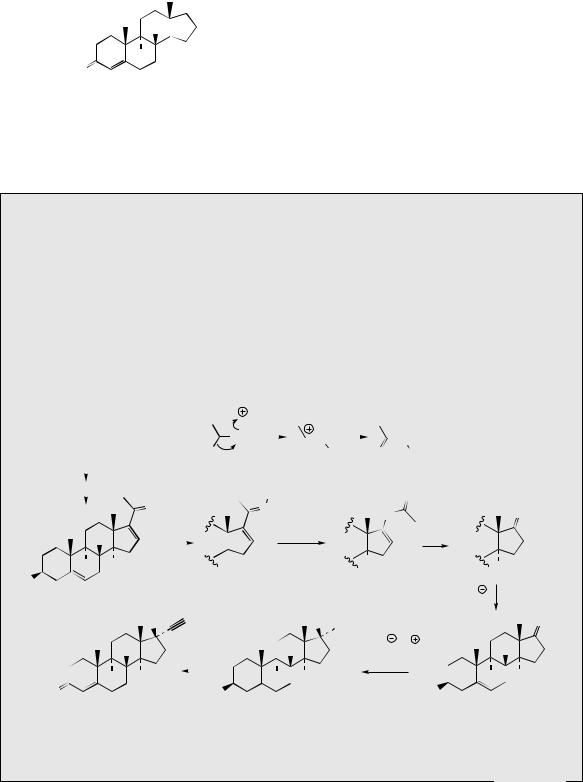
 O
O
|
H |
3 |
H H |
4 |
O
progesterone
Characteristic features of progestogens:
•C21 pregnane skeleton
•∆4-3-keto
Figure 5.128
STEROIDS |
273 |
Oestrogens
The oestrogens (US spelling: estrogens) are female sex hormones produced in the ovaries, and also in the placenta during pregnancy. They are responsible for the female sex characteristics, and together with progesterone control the menstrual cycle. Oestrogens were first isolated from the urine of pregnant women, in which levels increase some 50-fold during the pregnancy. In horses, levels rise by as much as 500 times during pregancy. Oestrogens occur both in free form, and as glucuronides
Progestogen Drugs
Quantities of progesterone (Figure 5.128) for drug use are readily available by semi-synthesis using the Marker degradation (see page 264). However, progesterone is poorly absorbed, and it is not suitable for oral use, being rapidly metabolized in the liver. Many semi-synthetic analogues have been produced, and it was thus appreciated that the α,β-unsaturated ketone system in ring A was essential for activity. The side-chain function at C-17 could be modified, and ethisterone (17α-ethynyltestosterone) (Figure 5.129), developed as a potential androgen, was found to be active orally as a progestational agent. This incorporates an ethynyl side-chain at C-17, a feature of several semi-synthetic steroidal hormones used as drugs. This group, referred to as ‘ethinyl’ in drug molecules, is introduced by nucleophilic
|
|
|
R′ |
|
OH2 |
|
R′ |
H2O R′ |
|
|||
diosgenin |
R |
|
N |
|
|
|
N |
|
O |
NH |
||
|
|
|
|
|
||||||||
|
|
|
|
|
R |
|
R |
|||||
|
|
|
|
|
|
|
|
|
||||
Marker |
|
|
Beckmann rearrangement: oxime → amide |
|
||||||||
|
|
|
|
|
|
|
|
|
|
|
|
|
degradation |
|
|
oxime formation |
|
|
OH |
|
|
|
|||
(Figure 5.119) |
|
|
|
|
|
|
O |
|||||
|
O |
|
|
|
|
|||||||
|
|
|
|
|
N |
|
HN |
|
||||
hydrolysis of amide function gives enamine; tautomerism to imine then allows further hydrolysis to ketone
O
NH2OH |
|
|
|||
H |
|
|
|
|
|
H H |
|
H |
|||
AcO |
|
|
|||
dehydropregnenolone |
|
|
|||
acetate |
Oppenauer |
||||
OH |
|||||
oxidation |
|||||
19 |
|
|
Al(OiPr)3 |
||
H |
Me2CO |
||||
|
|
|
|||
H H |
|
|
|
||
|
HO |
||||
O |
|||||
ethisterone |
|
|
|||
ArSO2Cl / Py |
HCl |
|
Beckmann  rearrangement H
rearrangement H
OH 
H |
HC |
|
C |
Na |
|
||||
|
||||
liq NH3 |
|
|||
|
|
|||
H  H
H
nucleophilic attack of |
HO |
|
|
acetylide anion on to carbonyl |
|
from less-hindered α face |
|
|
H |
|
hydrolysis of |
HO |
ester at C-3 |
|
O |
H
H  H
H
androstenolone
Figure 5.129
(Continues)

274 |
|
THE MEVALONATE AND DEOXYXYLULOSE PHOSPHATE PATHWAYS |
||||||||
|
|
|
|
|
|
|
|
|
|
|
|
(Continued ) |
|
|
|
|
|
|
|
|
|
|
|
|
|
O |
|
OH |
|
|
OAc |
|
|
|
|
|
17 |
|
|
|
|
|
|
|
H |
H |
14 |
H |
H |
H |
H |
|||
|
|
|
|
|
|
|
|
|
|
|
|
|
H |
|
H |
H |
H |
H |
H |
||
|
O |
|
|
O |
|
O |
|
|
|
|
|
19-nor-14β,17α-progesterone |
norethisterone |
norethisterone acetate |
|||||||
|
|
|
|
|
Figure 5.130 |
|
|
|
|
|
attack of acetylide anion on to a C-17 carbonyl (Figure 5.129), attack coming from the |
||||||||||
α-face, the methyl C-18 hindering approach from the β-face. The substrate androstenolone |
||||||||||
is readily obtained from the Marker degradation intermediate dehydropregnenolone acetate |
||||||||||
(Figure 5.119). The oxime (Figure 5.129) is |
treated with a sulphonyl chloride in pyridine |
|||||||||
and undergoes a Beckmann rearrangement in which C-17 migrates to the nitrogen giving |
||||||||||
the amide. This amide is also an enamine and can be hydrolysed to the 17-ketone. |
||||||||||
Acetylation or other esterification of the 17-hydroxyl in progestogens increases lipid solubility |
||||||||||
and extends the duration of action by inhibiting metabolic degradation. Examples include |
||||||||||
norethisterone acetate, medroxyprogesterone acetate, and hydroxyprogesterone caproate, |
||||||||||
discussed below. |
|
|
|
|
|
|
|
|||
|
Though considerably better than progesterone, |
the oral activity of |
ethisterone is |
|||||||
still relatively low, and better agents were required. An important modification from |
||||||||||
ethisterone was the 19-nor analogue, norethisterone and its ester norethisterone acetate |
||||||||||
(Figure 5.130). Attention was directed to the 19-norsteroids by the observation that 19-nor- |
||||||||||
14β,17α-progesterone (Figure 5.130), obtained by degradation of the cardioactive glycoside |
||||||||||
strophanthidin (see page 250), displayed eight times higher progestational activity than |
||||||||||
progesterone, despite lacking the methyl C-19, and having the unnatural configurations at |
||||||||||
the two centres C-14 (C/D rings cis-fused) and C-17. Norethisterone can be synthesized |
||||||||||
from the oestrogen estrone (see page 279) which already lacks the C-9 methyl, or from |
||||||||||
androstenolone (Figure 5.129) by a sequence which allows oxidation of C-19 to a carboxyl, |
||||||||||
which is readily lost by decarboxylation when adjacent to the α,β-unsaturated ketone |
||||||||||
system. |
|
|
|
|
|
|
|
|
||
|
Although ethisterone and norethisterone are structurally C21 pregnane derivatives, they |
|||||||||
may also be regarded as 17-ethynyl derivatives of testosterone (see |
page 282), the |
|||||||||
male sex hormone, and 19-nortestosterone respectively. Many of the commonly used |
||||||||||
progestogens fall into these two classes. Semi-synthetic analogues of progesterone, still |
||||||||||
containing the 17-acetyl side-chain, tend to be derivatives of 17α-hydroxyprogesterone, |
||||||||||
another biosynthetic intermediate on the |
way to |
hydrocortisone (Figure 5.114) that |
||||||||
also has progesterone-like activity. Examples include hydroxyprogesterone caproate, |
||||||||||
and gestonorone (gestronol) |
caproate (Figure 5.131). Medroxyprogesterone acetate |
|||||||||
(Figure 5.131) contains an additional 6α-methyl, introduced to block potential deactivation by |
||||||||||
metabolic hydroxylation, and is 100–300 times as potent as ethisterone on oral administration. |
||||||||||
Megestrol acetate (Figure 5.131) contains a 6-methyl group and an additional ∆6 double |
||||||||||
bond. Norgestrel (Figure 5.131) is representative of progestogens with an ethyl group |
||||||||||
replacing the 13-methyl. Although these can be obtained by semi-synthesis from natural |
||||||||||
13-methyl compounds, norgestrel is produced by total synthesis as the racemic compound. |
||||||||||
|
|
|
|
|
|
|
|
|
(Continues) |
|
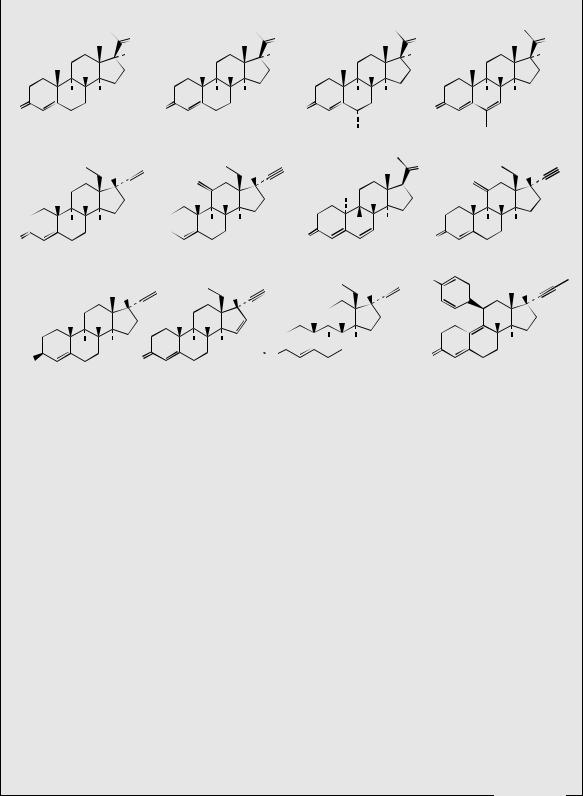
|
|
|
|
|
|
STEROIDS |
|
|
|
|
275 |
|
(Continued ) |
|
|
|
|
|
|
|
|
|
|
|
O |
|
|
|
O |
|
|
O |
O |
||
|
|
|
|
|
|
|
|||||
|
|
O2CC5H11 |
|
|
|
O2CC5H11 |
|
|
OAc |
OAc |
|
|
H |
|
|
H |
H |
|
H |
|
|
|
H |
|
H |
H |
|
H |
H |
H |
H |
|
H |
H |
|
O |
O |
|
|
|
O |
6 |
|
O |
|
||
|
hydroxyprogesterone |
gestonorone (gestronol) |
|
|
|
|
|||||
|
|
|
|
|
|
||||||
|
caproate (hexanoate) |
caproate (hexanoate) |
medroxyprogesterone |
megestrol acetate |
|||||||
|
|
|
|
|
|
|
acetate |
|
|
|
|
|
|
OH |
|
|
|
OH |
|
|
O |
OH |
|
|
|
|
|
|
|
|
|
|
|||
|
H H |
|
H |
H |
|
H |
|
|
H |
H |
|
|
H |
H |
|
H |
H |
|
H |
H |
|
H |
H |
O |
|
|
|
|
O |
|
|
O |
|
||
|
(–): levonorgestrel |
desogestrel |
|
dydrogesterone |
|
etonogestrel |
|||||
|
(±): norgestrel |
|
|
|
|
|
Me2N |
|
|||
|
|
|
|
|
|
|
|
|
|||
|
|
OAc |
|
|
OH |
|
OAc |
|
|
OH |
|
|
|
|
|
|
|
|
|||||
|
|
|
|
|
|
|
|
|
|
||
|
H |
H |
H |
H |
|
H |
H |
|
|
|
H |
|
|
|
|
|
|
|
|
||||
|
H |
H |
H |
H |
HO |
H H |
|
|
|
H |
|
|
|
|
|
|
|
||||||
|
|
|
|
|
|
|
|
O |
|
||
AcO |
O |
|
|
|
N |
|
|
|
|||
|
|
|
|
|
|
|
|
|
|||
|
etynodiol (ethynodiol) |
gestodene |
|
norgestimate |
|
mifepristone |
|||||
|
diacetate |
|
|
|
|
|
|
|
|
|
|
Figure 5.131
Since only the laevorotatory enantiomer which has the natural configuration is biologically active, this enantiomer, levonorgestrel, is now replacing the racemic form for drug use. In desogestrel (Figure 5.131), further features are the modification of an 11-oxo function to an 11-methylene, and removal of the 3-ketone. Structures of some other currently available progestogen drugs are shown in Figure 5.131.
During pregnancy, the corpus luteum continues to secrete progesterone for the first three months, after which the placenta becomes the supplier of both progesterone and oestrogen. Progesterone prevents further ovulation and relaxes the uterus to prevent the fertilized egg being dislodged. In the absence of pregnancy, a decline in progesterone levels results in shedding of the uterine endometrium and menstruation. Progestogens are useful in many menstrual disorders, and as oral contraceptives either alone at low dosage (progestogenonly contraceptives, e.g. norethisterone, levonorgestrel) or in combination with oestrogens (combined oral contraceptives, e.g. ethinylestradiol + norethisterone, ethinylestradiol + levonorgestrel). The combined oestrogen–progestogen preparation inhibits ovulation, but normal menstruation occurs when the drug is withdrawn for several days each month. The low dosage progestogen-only pill appears to interfere with the endometrial lining to inhibit fertilized egg implantation, and thickens cervical mucus making a barrier to sperm movement. The progestogen-only formulation is less likely to cause thrombosis, a serious side-effect sometimes experienced from the use of oral contraceptives. There appears to be a slightly higher risk of thrombosis in patients using the so-called ‘third generation’ oral
(Continues)
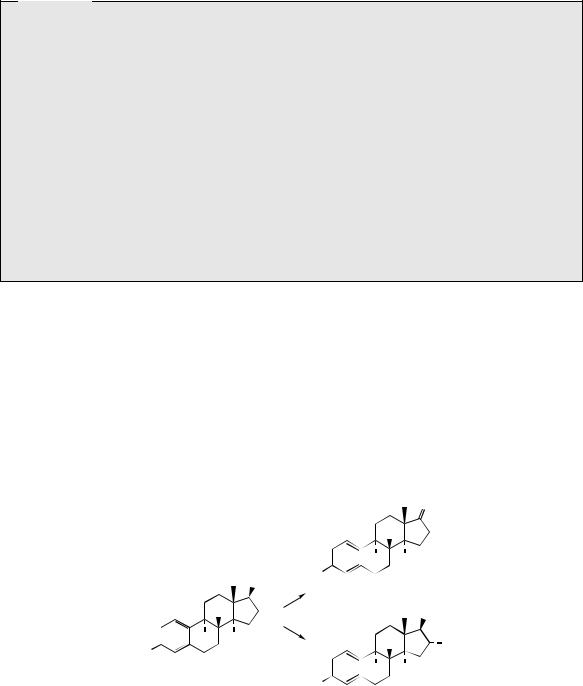
276 |
THE MEVALONATE AND DEOXYXYLULOSE PHOSPHATE PATHWAYS |
(Continued )
contraceptive pills containing the newer progestogens desogestrel and gestodene. Current oral contraceptives have a much lower hormone content than the early formulations of the 1960s and 1970s, typically about 10% of the progestogen and 50% of the oestrogen content. Deep muscular injections of medroxyprogesterone or norethisterone esters, and implants of levonorgestrel can be administered to provide long-acting contraception. A high dose of levonorgestrel, alone or in combination with ethinylestradiol, is the drug of choice for emergency contraception after unprotected intercourse, i.e. the ‘morning-after’ pill. Hormone replacement therapy (HRT) in non-hysterectomized women also uses progestogen–oestrogen combinations (see page 279), whilst progestogens such as norethisterone, megestrol acetate, medroxyprogesterone acetate, and gestonorone caproate also find application in the treatment of breast cancers.
Mifepristone (Figure 5.131) is a progestogen antagonist used orally as an abortifacient to terminate pregnancy. This drug has a higher affinity for the progesterone receptor than does the natural hormone, and prevents normal responses. This leads to loss of integrity of the uterine endometrial lining, and detachment of the implanted fertilized egg.
at position 3; they are not restricted to females since small amounts are produced in the male testis. The principal and most potent example is estradiol (also oestradiol, but US spelling has been generally adopted), though only low levels are found in urine, and larger amounts of the less active metabolites estrone (oestrone) and the 16α-hydroxylated derivative estriol (oestriol) are present (Figure 5.132). Estrone has also been found in significant quantities in some plant seeds, e.g. pomegranate and date palm. These compounds
have an aromatic A ring, a consequence of which is that C-19, the methyl on C-10, is absent. There is now no carbon side-chain at C-17, and the basic C18 skeleton is termed estrane.
The biosynthetic pathway to estradiol and estrone (Figure 5.133) proceeds from cholesterol via pregnenolone and bears a resemblance
to |
the |
hydrocortisone pathway (Figure 5.114) |
in |
the |
early 17-hydroxylation step. Indeed, the |
same cytochrome P-450-dependent enzyme catalyses 17-hydroxylation of both pregnenolone and
|
|
|
|
|
O |
|
|
|
|
H |
|
|
|
|
|
H |
H |
|
|
|
|
||
|
|
OH |
HO |
|
|
|
|
|
estrone |
|
|
|
|
|
|
|
|
|
|
|
|
(oestrone) |
|
|
H |
|
|
|
OH |
|
H H |
|
|
H |
OH |
|
|
|
|||
HO |
|
|
|||
|
|
|
|
||
|
estradiol |
|
|
H |
H |
|
|
|
|||
|
(oestradiol) |
|
HO |
|
|
|
|
|
|
||
|
|
|
|
estriol |
|
|
|
|
|
(oestriol) |
|
Characteristic features of oestrogens:
•C18 estrane skeleton
•aromatic A ring (consequent loss of C-10 methyl)
•no side-chain
Figure 5.132
